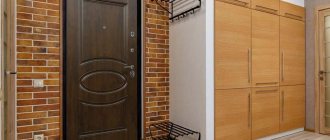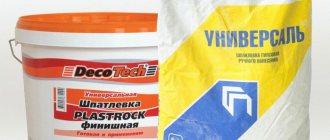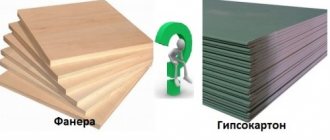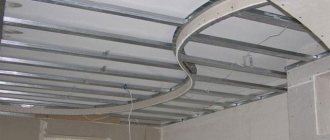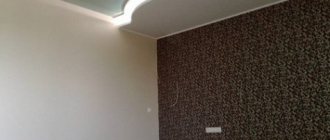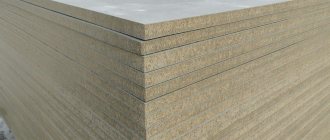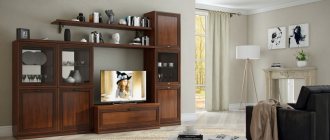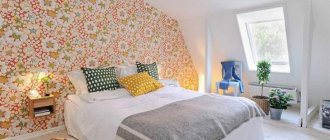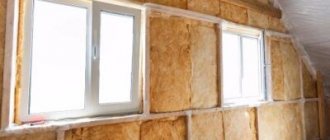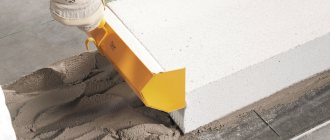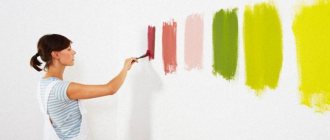Nowadays, it is very difficult to imagine a good renovation, for example, with a multi-level ceiling, without the use of plasterboard. Today, plasterboard is the most popular and widespread material for finishing walls and installing partitions. It is multifunctional and can be used to decorate walls, ceilings, and floors. It can be used to create decorations in the house, or it can be used to build a partition between rooms.
Advantages of drywall
Thermal insulation properties
The first advantage of drywall is its excellent thermal insulation characteristics. Drywall, of course, is far from brick, but it is quite a bit behind it in its thermal insulation abilities. And if you insulate it with foam plastic or mineral wool, then this design will allow you to significantly save on heating costs in the cold season.
Flexibility and lightness
The second advantage of drywall is its flexibility and ease of use. With the help of this material you can bring to life the most interesting and unusual ideas. You can create any shape from it - from rectangular cascades on the ceiling to semicircular arches. It can also be used for making various types of niches or installing built-in lamps.
Fire resistance
Another important advantage is the good fire resistance of the material. In the event of a fire, only the top cardboard layer will be exposed to fire, and even then only on the side of the fire. In addition, you can use not standard, but special fire-resistant plasterboard sheets that are not afraid of fire at all.
Water resistance
Special moisture-resistant plasterboard sheets do not absorb moisture. Thus, they can be safely used in the kitchen and bathroom without fear of deformation and destruction of the finish.
Hiding communications using drywall
Easy hiding of communications is another advantage of drywall. The space that is created after installing the panel is great for hiding unnecessary wires or other communications. But it is worth considering that if you do not make special inspection hatches, then if it is necessary to repair communications, you will have to remove the entire panel in search of a breakdown.
Pros and cons of finishing walls with plasterboard
Drywall is a universal material, without which no repair can be completed. It is used to make niches, false walls, and also to level walls and ceilings. This method of finishing surfaces has gained such high popularity for the reason that it is cheap, does not require the master to have special skills, and also allows you to install additional layers under the finish that perform the functions of insulation and sound insulation.
But before you start leveling the walls with plasterboard, you should ask whether this technology is completely suitable for you and whether it is not inferior to plastering work in any respect.
Disadvantages of drywall
Fragility
The main disadvantage of drywall is its lack of strength. Drywall sheets may crack during transportation, installation or use. Therefore, you should be especially careful when finishing or erecting partitions, or better yet, entrust this task to an experienced builder.
For this reason, it is not recommended to use drywall where heavy loads on the walls are expected. If you plan to install shelves, a TV stand and other heavy structures on the wall, you should use a double layer of plasterboard for finishing. This is the only way to ensure secure fastening.
Soundproofing properties
The next, although not significant, disadvantage is poor sound insulation. All sounds will be heard through the partition. But there is a way out: you can put mineral wool or any other soundproofing material between the slabs.
Is it possible to attach shelves to drywall?
Another disadvantage of drywall is its inability to support weights. That is, it will be quite problematic to install a TV or some kind of shelf on it. It is better to think through the design and construction of the room in advance so that you can build a frame for the necessary accessories. There is a second option that can correct this drawback: a double layer of 12.5 mm sheets and special butterfly dowels can be used. Another option is to make shelves in the form of niches in the wall from plasterboard
Sealing joints
Drywall seams are primed along the entire length to a width of 5-7 cm. Not only the special Tiefen Grund primer from Knauf is suitable for this, but also aqueous solutions of PVA or latex.
Then, using a spatula, cover the heads of the screws with a gypsum-based leveling mixture and fill the joints to the full depth. Knauf offers Fugen or Uniflott gypsum putty mixtures for this, but other gypsum-based mixtures can also be used.
Without waiting for the mixture to harden, lay sickle tape over the seams, pushing it down with a spatula and covering it with another layer of putty.
After drying, the joints are sanded with sandpaper - without causing damage to the gypsum board cardboard. If additional leveling is necessary, the seams are primed and leveled again.
To complete the final finishing, the walls are finally primed over the entire area.
How to choose drywall
When purchasing plasterboard slabs, you should look at the material from which it was created. Natural gypsum is considered the best. Artificial gypsum contains a small part of radioactive particles.
You also need to consider what drywall properties you need. Depending on this, you can choose standard, fire-resistant or moisture-resistant material with different sheet sizes.
Izolux specialists will calculate the drywall, profile and all other necessary materials for your idea. Contact us!
Which wall covering is better - plaster or drywall?
This question can only be answered in relation to each specific case, since the disadvantages of each of these technologies are compensated by individual advantages.
Advantages of gypsum board over plaster:
- Surface evenness at high speed and ease of execution;
- No concomitant pollution of the apartment.
Advantages of plaster over gypsum plasterboard:
- High strength characteristics of the coating;
- Lower cost.
If the geometry of the room is not consistent, that is, the walls have deviations from the vertical, the angles between them are not right, but the wall surface is even and smooth, then it makes no sense at all to transform the room into an ideal parallelepiped. Visually, these deviations are not noticeable; moreover, a significant part of the wall area is hidden by furniture and household equipment. In such a situation, leveling, as always, will cost significant money, but no one will notice the result. Moreover, any reduction of the walls to the vertical “steals” the dimensions. But another question is when the wall surface is wavy, and the existing finish only emphasizes this wavyness - such walls cannot be refinished without leveling. And here you have to choose how, if you want a good result, you can do it faster and at less cost. There are several criteria for assessing the situation in this case. Let's consider the main one - cost.
The least expensive solution to the problem is to level problem areas of the walls by plastering or puttying. This will not correct the geometry of the room, but will improve the quality of the surface and allow for a new finish.
Significantly more expensive is complete plastering - with the dismantling of the old finish, beacons, mortar and many other operations that take a long time and are accompanied by dirt in the apartment. But it should be borne in mind that the result (with the appropriate qualifications of the master) will be an even, strong and durable coating that is “set and forgotten.”
Leveling with plasterboard is possible on at least one wall as a whole. Cost calculations show that the frameless method will be cheaper than solid plaster. Installing gypsum plasterboard on a frame with a seemingly small list of materials and a simple design is more expensive than plastering.
Color spectrum
GKL has a wide range and is one of the most purchased building materials. Each type of product has its own size, properties and technical indicator.
When purchasing drywall, it is important to remember that its color indicates the features and specifics of the application. You also need to take into account that the color of the material will not affect the external finish.
It is customary to construct interior partitions from gray gypsum boards or use them to line walls. Such sheets are the most affordable material for cladding surfaces in buildings with normal moisture and temperature levels.
Green plasterboards are characterized by increased moisture resistance, so they can be used in rooms with a humidity of more than 65 percent. Red or pink gypsum boards are fire-resistant, so they are used for ventilation and fireplaces. Yellow plasterboard is suitable for external work because it is not afraid of moisture, drafts and direct sunlight.
Types of plasterboard sheets
Modern manufacturers now, in addition to standard plasterboards, produce fire-resistant (GKLO) and moisture-resistant (GKLV) boards.
Fire-resistant plasterboard sheets are intended for premises where increased fire resistance is required. Glass fiber is added to the boards, thanks to which the gypsum core is reinforced and prevents the destruction of the sheet during a fire. Such slabs are used in communication shafts and air ducts; they are used to install fire barriers.
For rooms with increased humidity, such as bathrooms, toilet rooms, saunas, moisture-resistant plasterboard sheets are used, the cardboard lining of which is treated with special agents that help protect the sheets from mold and mildew, as well as increase moisture resistance.
In such rooms with increased humidity, plasterboard is covered on the front side with special putties, waterproof paints, primers, PVC or ceramic tiles, and in case of direct contact with water, waterproofing must be used.
The modern building materials market widely represents all kinds of drywall. This is a very popular material for interior renovation and construction, due to its universal properties and relatively low price. After reading this article, you will definitely want to try this material in your work, and we can confidently assume that you will be satisfied!
Material Details
Drywall is a material consisting of cardboard sheets glued together using a gypsum mixture. Such a sheet (gypsum plasterboard) has reinforcement that gives it strength due to reinforcing additives.
Leaf structure
Thanks to this structure, gypsum boards have the following advantages:
- ease and ease of installation with your own hands;
- environmental friendliness;
- moisture resistance and fire resistance;
- mechanical strength;
- good thermal insulation performance;
- the ability to “breathe”, which allows the material to absorb excess moisture in the air;
- plastic.
Because of these advantages, drywall has taken first place in popularity as a finishing material for do-it-yourself interior work.
